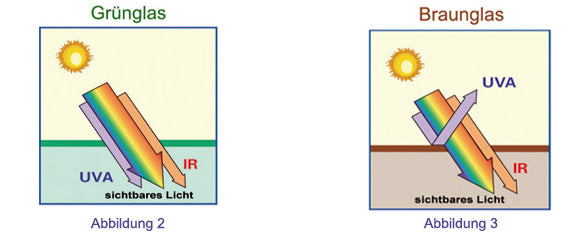
Originally, hunter-gatherer cultures, of which few remain today, would create ingenious tools and vessels for collecting, storing and delivering food, water and medicines. Things like stone, tree bark, branches, leaves, grasses and animal hides were routinely employed and strategically manipulated into containment vessels. These creations were quite resilient and elegant, as well as being organic and gentle to the contents therein.
 Apparently, the early Egyptians were the first people recorded to produce dark violet glass, pictured above. They were sophisticated enough to understand that certain substances required an absence of light in order to preserve their vital essences. Gold was another manufactured ingredient put into practice for this purpose. Water and precious oils were safely stored in gold and dark violet vessels. Many, many years later, some of these sacred liquids have been recovered and found to be nearly as viable as the time they were sealed. This phenomenon has been routinely put to the test and repeated under the scrutiny of modern scientists, as we will see further on.
Apparently, the early Egyptians were the first people recorded to produce dark violet glass, pictured above. They were sophisticated enough to understand that certain substances required an absence of light in order to preserve their vital essences. Gold was another manufactured ingredient put into practice for this purpose. Water and precious oils were safely stored in gold and dark violet vessels. Many, many years later, some of these sacred liquids have been recovered and found to be nearly as viable as the time they were sealed. This phenomenon has been routinely put to the test and repeated under the scrutiny of modern scientists, as we will see further on.
Then there is evidence that the alchemists of the Middle Ages were also privy to the protective qualities that this particular dark glass provided. The production of dark violet glass had fallen out of favour since that era, in part because of corporate financial interests influencing the mass market of manufacturing, producing a whole host of disposable products to satisfy consumers and industry needs. Packaging is big business.
The truth is that plastic, metal alloy s and lighter shades of glass, pale in comparison and can't hold a candle up to the opaque shadow that this dark violet glass casts over them.
s and lighter shades of glass, pale in comparison and can't hold a candle up to the opaque shadow that this dark violet glass casts over them.
Now that is all very interesting but what is really so special about this inky black glass? Come with me down the rabbit hole.
We all understand that sunlight enables plants to grow. In fact sunlight is vital to all life on Earth. However, the effect of the sun's light changes after plants are harvested, accelerating the molecular decaying process. Miron glass acts as an "antioxidant glass" that works essentially like a natural filter. Quality and aromas are improved by allowing in the three frequencies of light that have been found to nurture and protect all organic matter: visible violet light, non-visible UVA and infrared light.
The human eye can only see the rainbow spectrum of colours with red at one end and violet at the other. Beyond these two colours are the infrared 
 and ultraviolet spectrums of non-visible light. Miron glass appears black, yet is truly violet and only penetrable to the visible spectrum of violet light, hence its colour. It effectively refracts the entire midrange spectrum of light.
and ultraviolet spectrums of non-visible light. Miron glass appears black, yet is truly violet and only penetrable to the visible spectrum of violet light, hence its colour. It effectively refracts the entire midrange spectrum of light.
Non visible far-infrared light is a powerful healing light frequency within the larger band of infrared light and sustains the molecular viability and structure of whatever is stored in Miron glass. These two frequencies are used nowadays in many healing modalities and technologies, such as saunas and dentistry.
The combination of these three frequencies of light is the brilliance of Miron glass science. A harmony of vibration is created that allows what is stored to be nurtured. Quite the opposite of the constant degradation to products in transparent glass, plastic and other packaging.
We are what we eat, so the question is simply this: would you rather ingest something that is constantly infiltrated by degrading light frequencies, off-gassing toxins and xeno-oestrogens, or something that is being nurtured by a harmony of life supporting light rays through an inert and attractive dark violet glass bottle?

Let's go a little bit deeper. The term biophotonics is made up of two Greek words: “bios” for life and “phos” for light. The science of Bio-photonics addresses medical and human science questions in the form of light based technologies. The main point of bio-photonic research is the application of the characteristics of light on food production, bio-technology and medicine. With the help of light, images of microscopically small processes within living cells can be observed quickly and undisturbed.
UV light is subdivided into three bands: UVA (320-400 nm), UVB (290-320 nm) and UVC (200-290 nm). The majority of UVC is filtered out by the ozone layer of the stratosphere and therefore very small amounts ever reach the surface of the Earth. UVC and UVB are able to induce mutations of the genome and can cause damage to skin after intense exposure to sun, especially in individuals suffering from xeroderma pigmentosum, a well known genetic disease. Interestingly, such genetic mutations are reversible by using UVA and violet light by means of so-called photo repair.
Clear, green and brown glass are permeable in the visible light spectrum and don’t offer enough protection against decomposition caused by light. As an experiment, several herbs and spices were stored for three months in several types of glass: clear, brown and violet.

After two months, the visible quality change was recorded with photographs and the difference in smell determined in a blind test with volunteers. The illustration shows clearly that the chive samples that were exposed to the sun have bleached in brown and clear glass and the sample stored in Miron violet glass has no colour change. The smell of the chives stored in Miron glass was also clearly stronger and fresher.
In order to more easily prove the quality protection given to food stored in Miron glass, a microbiological experiment was carried out with cherry tomatoes. During this test, a cherry tomato was stored for seven months in a clear glass and another in a Miron glass bottle and kept at room temperature where sunlight could reach it. The result was then photographed and the microbiological changes of the tomatoes can be clearly seen. No contest.

A customer of ours has repeated this experiment recently, and brought the results to show us. It was very impressive!
We have conducted our own experiments at home and are convinced that Miron glass is indeed superior to all other types of glass. It's the ideal bottle choice for carrying water, housing precious oils, safekeeping herbs, long term storage of seeds and many other things. When it comes to preservation of quality, enhancing the life-force and for its sheer beauty and elegance, Miron violet glass cannot be beaten.

Our drinking water being "charged" by sunlight in a Miron glass bottle.
(Partially adapted from an article by David Whipple, with his kind permission https://davidwhipple.com )

